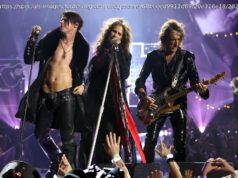Here’s what its successors can take away.
The modern live musical TV special is a bizarre animal. Since NBC revived the live musical tradition in 2013 with The Sound of Music Live, these specials have managed to drive conversation and draw massive ratings on a fairly reliable basis — but they haven’t reliably managed to be, well, good. (For exceptions, see The Wiz .)
But Sunday night’s live production of the ’70s British megamusical Jesus Christ Superstar, starring John Legend as the Messiah and Hamilton vet Brandon Victor Dixon as Judas, was a welcome exception to the rule. Superstar glittered its way through the last days of Christ — on Easter Sunday, no less — with enormous energy and verve, and managed to stick the landing with an unforgettable final image.
Jesus Christ Superstar Live has officially raised the bar for the live TV musicals to come. Here are some lessons they can take away from its success.
Musicals are an inherently artificial medium, especially when they’re live, and that makes them a tricky fit for the intimacy of television. In our current spate of live TV musicals, that problem shows most in the airlessness of the sets. Remember the weird dollhouse set of Sound of Music Live, or the empty, echoing gym of Grease Live? They were trying to find a balance between theatrical artifice and the photorealism TV audiences have come to expect, but they struggled, and it showed.
But Jesus Christ Superstar split the difference between its two media with arena-concert-style staging. Jesus, Judas, and company walked out onto an elaborate stage surrounded by an audience on all sides, and proceeded to perform their show as though it were a rock concert — and in the process, they avoided all the stifled, airless sweatiness that has plagued previous TV musicals. Instead, Jesus Christ Superstar fizzed and sparked with energy.
This approach does have its downsides — the audience’s endless cheering nearly drowned out the vocals in some cases — but for my money, they’re more than balanced by the upsides. And the rock concert approach is one that specifically works for Jesus Christ Superstar, which began its life as a rock concept album. A smaller, more intimate musical might not benefit from arena staging — but it could easily manage the small scale of, say, a live late-night TV musical performance or similar, where the give-and-take between performer and audience is tangible and relatable to viewers at home.
But the larger lesson is one that all live TV musicals can learn from: S trict photorealism is not your friend. The trick is to borrow from performance styles that already have accepted cinematographies, that audiences know how to watch on television already. We’re used to watching rock concerts on TV. We know what they’re supposed to look like. So when the cast of Jesus Christ Superstar Live took the stage, they didn’t have to acclimate to how we should be watching them. We already knew how, instinctively.
Musicals can either be made up of a mixture of songs and dialogue (think Sound of Music, Into the Woods, Rent the movie) or they can be made up entirely of songs, or sung-through (think Hamilton, Les Miserables, and Rent the stage musical). Most of the previous live TV musicals have had a mixture of songs and dialogue, but Jesus Christ Superstar is sung through, and that made an enormous difference in the energy levels of the show.
When a musical has both songs and dialogue, the audience has to move back and forth between different layers of artifice and emotional reality: N ow we’re in a grounded and realistic world where people talk, now we’re in a heightened world where people sing. On stage or in a prerecorded screen performance that has the benefit of production, these transitions can feel seamless and natural. But in the live TV specials, which already struggle to balance the demands of both TV intimacy and theater flamboyance, the transitions feel labored. They don’t flow naturally.
Because Jesus Christ Superstar is sung-through, the audience didn’t have to switch back and forth between realities. Once the cast was onstage singing, the audience was fully immersed in the heightened world of the musical, and could stay there for the entire run of the show. Not every musical can pull this off, but those that can — looking at you, Rent, which is set for the live TV treatment on Fox in 2019 — should take note.
The other two lessons have focused on how to deal with the liability of the live TV musical special and how to handle its many weaknesses. But it’s also good to remember the thing that a live TV musical special can handle better than any other medium: spectacle. The live TV musical can combine the precarious thrill of live theater spectacle (are they gonna pull it off, are they gonna pull it off, oh my god they did it!) with the money and resources of a TV show. They can do magic.
In Jesus Christ Superstar Live, the spectacle was as simple and evocative as the shot of the back of the stage opening up, forming a cross made out of negative space, as Jesus’s cross floats back into the fog. It’s a moment that would do very little in a produced movie, and the effects could be tricky to handle in a theater. But in a live TV musical special, it became the kind of extraordinary, haunting image that future live TV musicals would do well to emulate.






